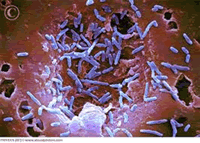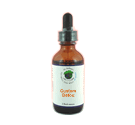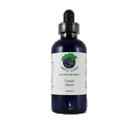|
|
Mycobacterium
 |
Mycobacteria are common in normal soils and natural water supplies. People frequently encounter these bacteria in the normal course of their lives. Mycobacteria are a large group of bacteria with nearly a hundred different species. However, only a few are of medical importance. These include: Mycobacterium tuberculosis which causes tuberculosis, Mycobacterium leprae which causes leprosy, and a group known as atypical mycobacteria or non-tuberculosus mycobacteria (or NTM), which cause a variety of skin, lung, and other infections. The following list focuses on non-tuberculous mycobacteria (NTM).
Mycobacterium avium complex, Mycobacterium kansasii, and Mycobacterium fortuitum complex cause most of NTM infections in humans. Other NTM species rarely cause infection, despite their prevalence in the environment. For example, Mycobacterium gordonae infections are rare, even though this organism is in most tap water in the United States.
- M. tuberculosis complex (TB) is one of the most common and deadly infectious diseases in the world.
- Mycobacterium leprae causes Leprosy, a chronic infectious disease affecting the skin, peripheral nerves, and mucous membranes.
- M. avium-intracellulaire complex (MAC), found worldwide, has become one of the most common infections in patients with AIDS. It typically starts in the lungs and spreads throughout the body.
- M. kansasii most frequently causes lung infections, it has increased prevalence in the South, especially Texas and Florida.
- M. abscessus may infect implants, such as pacemakers.
- M. chelonae may cause post-surgical infections in artificial heart valves and prosthetic implants.
- M. fortuitum may cause post-surgical infections.
- M. xenopi is found in hot water systems often as a contaminant.
- M. scrofulaceum may cause cervical adenitis (infection of the lymph nodes in the neck), especially in children.
- M. marinum, found in fresh and salt water, aquariums and swimming pools; infects through breaks in the skin and may cause persistent sores. Found worldwide and often associated with AIDS.
- M. ulcerans, endemic in the tropics, causes large lesions or ulcers and is the 3rd most common mycobacterial infection in healthy people.
- M. intermedium very rarely causes skin and pulmonary infections in immunosuppressed people.
- M. malmoense is more common in U.K., northern Europe but uncommon in U.S.
- M. haemophilum, rarely isolated, requires specific growth factors for isolation.
- M. szulgai, rarely isolated, is not an environmental contaminant.
- M mucogenicum causes central venous catheter infections.
- M. gordonae is the most common NTM contaminant.
- M. mucogenicum, usually a contaminant, rarely causes central venous catheter infections.
- M. nonchromogenicum and M. terrae, usually a contaminant, can cause tenosynovitis (inflammation of the lining of the sheath that surrounds a tendon).
- M. immunogenum is rare and is associated with pseudo-outbreaks.
- M. genavense causes AIDS.
- M. avium subspecies paratuberculosis, causes Johne disease in cattle. Some people think it may cause Crohn's Disease and/or irritable bowel syndrome in people.
This Quantum Formula antidotes the various species and subspecies in the Mycobacterium genus.
|
|
| |
Mycobacterium Detox Remedy
Detoxification of all Mycobacterium toxins and poisons
$14.95
Read/Write Reviews
|
 Add
To Cart Add
To Cart |
 |
 |
Liquid Detox
Help that itch, burn, rash, infection.
$39.95
|
 Add
To Cart Add
To Cart |
 |
 |
Mycoplasma Detox Remedy
Detoxification of all Mycoplasma toxins and poisons
$14.95
|
 Add
To Cart Add
To Cart |
 |
 |
|
|
 Arthropod/Vector
Bacteria
Chemicals
Fungus /Mold
/ Yeast Metals Parasites Virus Other
Arthropod/Vector
Bacteria
Chemicals
Fungus /Mold
/ Yeast Metals Parasites Virus Other



